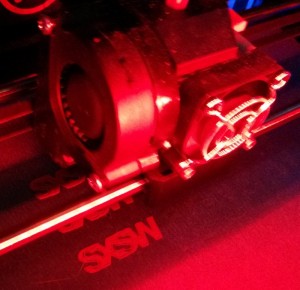Digging Into A Few Of SXSW 2013’s Disruptive Dreams
 AUSTIN–Attempting to stay on top of the chatter at South By Southwest Interactive is a fool’s errand. Even if you could commute by jetpack around town, the density of the schedule ensures that you will only get into maybe one in three panels that you think interesting.
AUSTIN–Attempting to stay on top of the chatter at South By Southwest Interactive is a fool’s errand. Even if you could commute by jetpack around town, the density of the schedule ensures that you will only get into maybe one in three panels that you think interesting.
The past few days, my second visit to SXSW, reminded me of this all over again. But through the haze of talks and demos attended and missed, the view of a few tech frontiers cleared up. Slightly.
3D printing: A perennial favorite at SXSW, this technology took a step forward with MakerBot’s introduction of a 3D laser scanner, the Digitizer; you can already render printable replicas of physical objects using software to process photos, but this could be easier and faster.
A fascinating panel later reminded me of 3D printing’s potential and risks. It can now work for customer support (Swedish synthesizer manufacturer Teenage Engineering lets customers print replacement knobs instead of paying to have them shipped) and may boost marketing too (witness Nokia’s inviting users to print its design for a phone case, which some have since upgraded). But when an audience member asked who would be responsible if a 3D printed part failed and somebody got hurt, there was no clear answer.
HTML5 apps: Web inventor Tim Berners-Lee used his keynote Saturday to tout the possibilities of Web apps. Today’s and tomorrow’s HTML5 standards, he said, will endow them with interactive features traditionally confined to “real” apps: responding to data from a phone’s accelerometer and other sensors, running video conferences and even incorporating digital-rights-management restrictions. (That last bit drew an almost 1,500-word dissent from online-liberties advocate Cory Doctorow.)
The HTML5 developers I talked to Sunday didn’t sound quite so gung-ho about Web apps displacing local ones. But on Tuesday, I saw an impressive demo of a Web-based site-authoring tool, Needly, that offered the kind of control over text styling and placement usually offered only in traditional desktop programs.
Mobile finances: When many major banks have yet to get around to supporting remote check deposit through smartphone camera scanning, there’s plenty of room left for smaller firms to innovate around them.
The food trucks circulating around Austin–well, those not subsidized by exhibitors to give away chow to hungry SXSWers–testified to the runaway popularity of Square and other mobile credit-card-processing apps. That trend may lower the ceiling on services that try to abstract plastic out of the transaction, such as SXSW exhibitor LevelUp and its zero-transaction-fee, no-card-number-visible system of letting you pay with a unique QR Code on your phone’s screen.
Also interesting: TreeSwing‘s play to make mutual funds appeal to 20somethings. Its app will let you invest as little as $1, aggregating those tiny transactions through its DST Market Services parent brokerage. If you want, it will also suggest you kick in a little more based on your activity (along the lines of “you’re at Starbucks, why not another $3”) or the date (“it’s Pi Day, invest $3.14”).
The etiquette of all this: The least predictable aspect of new technology’s arrival may be how people respond to it as they (perhaps) get over early awkwardness and create new norms. Highlight founder Paul Davison, whose people-discovery app didn’t quite live up to the hype at last year’s SXSW, noted how users have tip-toed their way into pinging strangers who also happen to use the app.
He described one shout-out a user received in the app: “Hi, say hi to your coworker Ken to me. He’s a really cool guy. I hope it’s okay that I sent that.”








